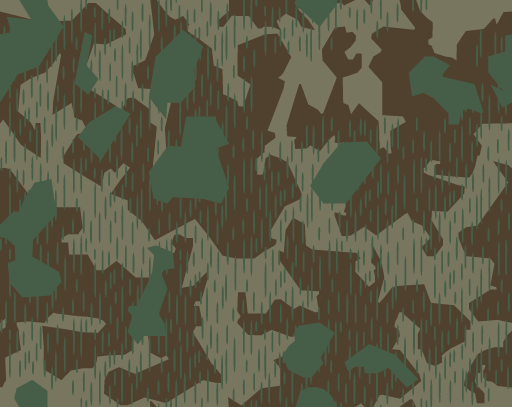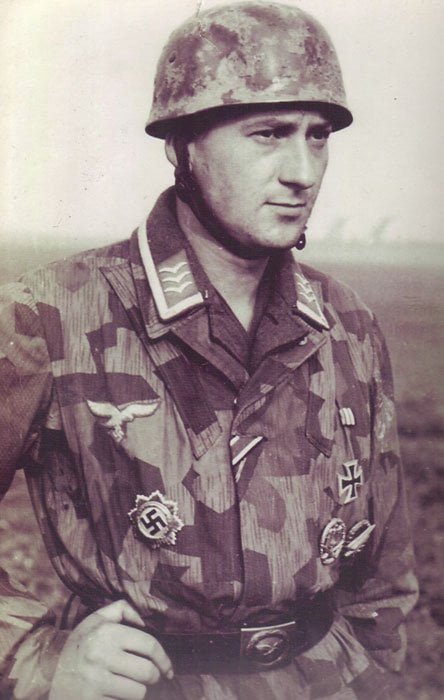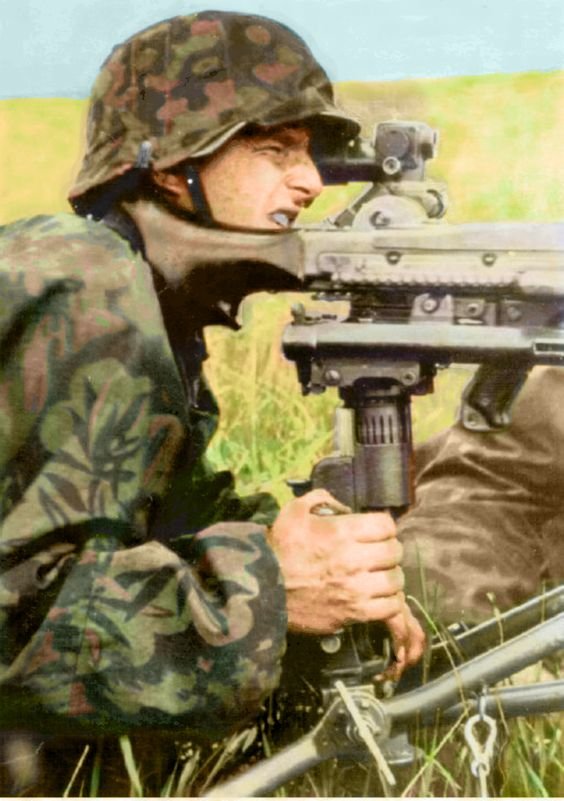GERMAN CAMOUFLAGE OF WWII
The history of German camouflage during the Second World War and as a whole is a very interesting subject. Artists study nature, seasons, sunlight reflections, and how our eyes perceive objects and patterns in different environments. I believe it's safe to say the Germans were the biggest pioneers in understanding and developing camouflage patterns that the rest of the world took note of. To understand the patterns developed in the Second World War, we have to know their origins.
What you can consider “true” camouflage came about in the first world war, but it wasn't until the second that it was produced and issued in a more personal way to soldiers in regards to uniforms and equipment. Camouflage at the time of World War One was mostly used to conceal artillery emplacements from aerial observation and was later applied to tanks, ships, and aircraft as well. A German artist named Franz Marc, an expressionist painter, was the most notable artist of many tasked by Germany to create camouflage designs to be printed on large tarpaulins. For Germany and most other nations as well, personal camo for soldiers first came about with steel helmets such as painted Stahlhelms with interesting and somewhat exotic geometric shapes and shades. Snipers on both sides became extremely savvy as well, crafting their own camo in the field.
After WW1, Germany became the first country to mass produce and issue camouflage uniforms to its army and undoubtedly became the most prolific developer of camouflage during the Second World War, implementing multiple variations and schemes of colors and patterns for the Wehrmacht, Luftwaffe, and Waffen SS. Many other nations during and after World War II were heavily influenced by Germany's camouflage innovations and followed suit with their own.
Wehrmacht & Luftwaffe Patterns
Buntfarbenaufdruck 31
(Splittermuster 31, Heeres-Splittermuster 31, Splinter Camo)
Pre World War II, circa 1931, the first mass produced camo called “Buntfarbenaufdruck 31” (later renamed “Heeres-Splittermuster 31” circa 1935) was introduced to the German army. This pattern, commonly referred to as just Splinter Camo, was the main army pattern from 1932 to 1945. As you may already notice, the pattern on this particular camo resembles the odd geometric shapes and schemes that you'd see on painted Stahlhelms from the First World War. This pattern was produced on equipment such as Zeltbahns, with one side being darker and the reverse being a lighter shade with a slightly different coloration, as well as uniform items like helmet covers, smocks, and parkas. All units in the German army were issued this pattern except the Waffen SS; the Luftwaffe also used this pattern but updated to a new pattern in 1941; the army followed with new patterns in 1943, but Zeltbahns were produced in the same pattern until 1945.
Buntfarbenaufdruck 31
Luftwaffe Splittermuster 41
(Splinter B, LuftwaffeSplinterMuster)
First used during Germany's invasion of Crete in 1941, this was essentially a scaled down version of the Wehrmachts Heeres-Splittermuster 31. This version had a smaller splinter pattern and was used in some Fallshirmjager uniforms such as the Knochensack which was a jump smock, Eventually, this pattern was also implemented on other gear such as Fallshirmjaeger helmet covers and bandoliers.
Splittermuster 41
Luftwaffe soldier wearing a Splittermuster 41 camo smock
Sumpfmuster 43
(43 Marsh Pattern, Swamp Camo, Tan & Water 43)
Utilized from 1943 to 1945, this was a widely used pattern derived from the Splittermuster 31. This pattern still somewhat shows the same geometric shapes but is more blurred and faded; the base color was beige or a kind of tan with maroon and dark green prints over it. These patterns appeared on helmet covers, Fallschirmjager smocks, bandoliers, and some field jackets. Some Waffen SS soldiers were seen wearing garments with this pattern as well.
Sumpfmuster 43
Sumpfmuster 44
(Tan & Water 44, Marsh Pattern 44)
This was another marsh style pattern developed from the Sumpfmuster 43 pattern. Used from 1944 until the end of the war, this version had almost identical colors to its predecessor, but now the geometric shapes are completely gone. This made it less recognizable to the human eye, as well as making it very similar to the camouflage used on German tanks during the war. This pattern was also seen on the same gear and garments as Sumpfmuster 43.
Sumpfmuster 44
WAFFEN SS PATTERNS
The Waffen SS had seven distinct camouflage patterns that worked extremely well and were way ahead of their time; many were produced in multiple color schemes. Camouflage smocks, helmet covers, and Zeltbahns were issued to Waffen SS troops as early as 1937; these patterns were also mostly reversible garments featuring spring and autumn camo designs. Waffen SS camo patterns were developed on a different basis than Germany's regular army. Waffen SS patterns were based on more organic shapes that reflected sunlight patterns in woodland environments. The credit for the development of such patterns belongs to Professor Otto Schick and his team.
Platanenmuster
(Plane Tree Pattern)
This was the first camouflage pattern to be used by the SS and has six numbered variations. First issued in 1937 and continued into 1943, the name “Platanenmuster” refers to the “Platanaceae'' species, also known as the sycamore. During research for development, Otto's team decided the most effective design would be a natural and irregularly flowing form without repeating. Two classes of patterns were derived from that decision: numbered Zeltbahn patterns and unnumbered smock patterns (Block, Lateral, Polyspot). The numbers on the Zeltbahns were distinctive and printed within the pattern to help those in the factory doing the printing and those cutting the cloth keep track of what they were working on. On reversible garments and Zeltbahns, the numbers usually came in pairs 1-2, 3-4, 5-6. Earlier 1-2 patterns were printed manually on screens big enough for the Zeltbahn's size, so the pattern does not repeat across the entire piece but instead flows. Garments like smocks on the other hand, usually have pattern breaks or repeats at the elbow seam but for both Zeltbahns and Garments it wouldn't be too uncommon to find small repeats of the pattern due to worker negligence and the pressure to produce for the war effort in Germany. Platanenmuster appeared on Zeltbahns, helmet covers, smocks: M38, M40, M42 and field caps as well.
Platanenmuster
Spring /Summer scheme of Platanenmuster
Rauchtarnmuster
(Blurred Edge)
In service from 1939 to 1944 and printed as a tri color oak leaf pattern with a two tone shadow. This pattern seems to be a development from the Platanenmuster 5-6 variations. This pattern was used on Zeltbahns and smocks.
Rauchtarnmuster
Rouchtarnmuster or “Blurred Edge” camo smock
Palmenmuster
(Palm Tree Pattern, Forest Pattern)
Issued from 1940 to 1943, this particular pattern is one of the rarest to find and appears to only be used on early designs of smocks. The colors on this pattern are very similar to Platanenmuster but resemble distinctive leaf and flower shapes. This pattern was widely used during the invasion of the USSR.
Palmenmuster
SS soldier wearing a Palmenmuster smock
Eichenlaubmuster
(Oak Leaf Pattern)
In use from 1941 to 1945, this camo became one of the most popular late war patterns that appeared in the widest variety of garments and equipment. This pattern has two variations: Oak A (1941) and Oak B (1943). Both of these patterns are similar to each other but the Oak B pattern has a thin shaded border around lighter spots. Most garments with the Eichenlaubmuster were reversible, with one side being a spring color scheme and the opposite being an autumn color scheme.
Erbsenmuster
(Pea Pattern, Dot 44)
In service from 1944 to 1945, this pattern came into service mid to late war. Erbsenmuster was used on multiple uniforms, such as the reversible winter parkas, overalls, tank jackets, smocks, and M43 and M44 field jackets. Winter parkas and winter trousers in particular reversed to white, making this pattern infamous with the Battle of the Bulge; the rest were made in a one way color and pattern to fit both autumn and spring.
Erbsenmuster
Waffen SS soldier wearing Erbsenmuster
Liebermuster
Introduced in 1945 during the last months of World War II, Liebermuster was the last camouflage pattern developed by Germany during the war. Its design consisted of five different colors and was the first to introduce infrared reflective inks, making it ahead of its time. Liebermuster was intended to become the standard pattern for the entire German army but the war ended before many units could receive them. Only a few units stationed in Czechoslovakia appeared to have received them. This pattern heavily influenced the development of several camouflages later on, such as the American EDRL pattern, the Czech Liebermuster pattern and the Swiss Leibermuster pattern.
Liebermuster
German soldier appears to be wearing Liebermuster camo. Prague, 1945.
All information provided in this writing has been researched by myself from various records available online as well as historical reference books covering German uniforms during the Second World War. I intend this writing to be a brief overview style piece to reference too when learning about camouflage, more specifically German camouflage during WWII. Bits and pieces of information have been left out due to my intent of making this a “brief overview’. As always, thank you for visiting The Garrison Militaria.
















